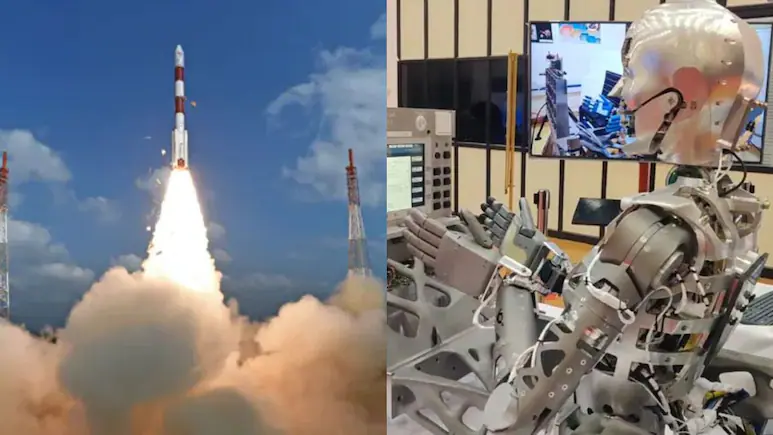ISRO’s Gaganyaan G1 Set to Launch with a “Half-Humanoid” in December
India’s space agency ISRO is preparing to launch Gaganyaan-1 (G1) — the first uncrewed test flight in the Gaganyaan human spaceflight programme — likely around December this year. The mission will carry Vyommitra, a half-humanoid robotic passenger designed to mimic human responses and validate spacecraft systems ahead of crewed flights. ISRO chairman V. Narayanan confirmed the timeline and the presence of the half-humanoid in public remarks. The aim of G1 is to validate re-entry, parachute deployment and crew-module safety before moving on to further uncrewed tests and ultimately crewed flights planned for later.
Why Gaganyaan is more than just a launch — it’s India building a human spaceflight story
Think of Gaganyaan like the moment a country decides to build a bridge not just across a river, but into a new frontier. It’s practical — faster access to science and applications — and symbolic: a marker of technological maturity. For India, Gaganyaan is the first sustained step toward sending Indians into low-Earth orbit on an Indian rocket and returning them safely. That requires precision engineering, rigorous testing, and a healthy appetite for risk mitigation.
G1 is the first chapter in that story — an uncrewed test mission whose job is to stress the spacecraft in real flight conditions and come home safely. It’s the difference between rehearsing in the theatre and performing live: the rehearsal (ground tests, flight-simulations) gets you ready, but only a real flight reveals how parts of the system behave together under cosmic stress.
G1 in December — yes, and with a half-humanoid called Vyommitra
ISRO’s chairman confirmed that Gaganyaan-1 (G1) is targeting a launch near December, and that the mission will carry Vyommitra, a “half-humanoid” robotic test passenger. In ISRO parlance, Vyommitra is a test-robot built to perform experiments and record cabin conditions that replicate what a human might experience — from cabin pressure and acceleration loads to environmental control responses. In short: Vyommitra is there to be the stand-in for a human being, but without the vulnerability.
Why “half-humanoid”? Unlike a full humanoid robot with limbs that move like a human, Vyommitra is essentially a torso and head with sensors, actuators and interfaces that simulate human presence and responses. That gives ISRO the ability to test life-support interfaces, seating ergonomics, communication links and automated emergency responses without putting a person at risk. Think crash-test dummy for the cabin — but wired to monitor physiology proxies and the environment.
What exactly will G1 test? The practical objectives of the flight
G1 is not meant to go for glory — it’s meant to validate critical safety elements. These include:
- Crew module behaviour during ascent and re-entry: verifying structural loads, thermal protection and orientation control during the harsh phases of flight.
- Parachute sequences and splashdown safety: the parachute system is a multi-stage arrangement that must deploy reliably to slow the crew module before sea landing; recent deliveries of indigenously developed parachutes to ISRO underline this priority.
- Telemetry and onboard system checks under real flight dynamics: sensors, control systems and communications must perform together under launch vibration and orbital conditions.
- Vyommitra’s data collection and experiment suite: environmental parameters, possible human-interface automation, and experiment sensors that simulate parts of a human physiological response.
FAQs — Five Unique Questions People Ask Right Now
1) What exactly is Vyommitra and why is it described as a half-humanoid?
Vyommitra is a human-simulation robot (a torso and head with sensors and actuators) designed to monitor cabin conditions, interact with crew-module interfaces and record data that mimic human presence. It’s a half-humanoid because it focuses on human-related measurements and interface testing rather than full-body locomotion.
2) When is Gaganyaan-1 scheduled to launch, and is that date fixed?
ISRO has publicly indicated a target near December for the G1 uncrewed mission, but such dates remain contingent on final integration and pre-flight tests. Target windows are common in spaceflight; they’re strong indicators of readiness but can shift for safety reasons.
3) What will G1 test that ground tests couldn’t?
G1 will expose the crew module and systems to real launch vibrations, thermal loads during re-entry, and parachute deployment dynamics — conditions that are extremely difficult to replicate perfectly on the ground. Real flight reveals system-level interactions and edge cases that laboratory environments may miss.
4) Has ISRO received all critical hardware for the mission, like parachutes?
Major hardware components such as indigenously developed parachute systems have been delivered to ISRO for assembly and integration, which is a key readiness step. This reflects cross-agency collaboration (e.g., DRDO’s ADRDE) in preparing for safe recovery testing.
5) If G1 is successful, when might India fly astronauts?
A successful G1 and follow-on uncrewed tests would clear significant technical hurdles. ISRO has signalled crewed flight windows in subsequent years (public commentary has referenced early 2027 as a target for a crewed mission), but the exact timing will depend on test outcomes and safety certifications.






